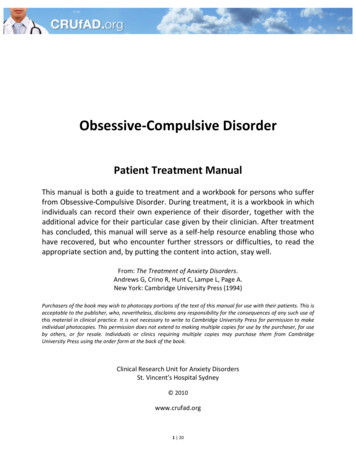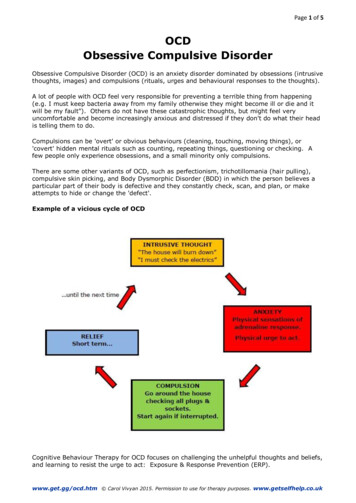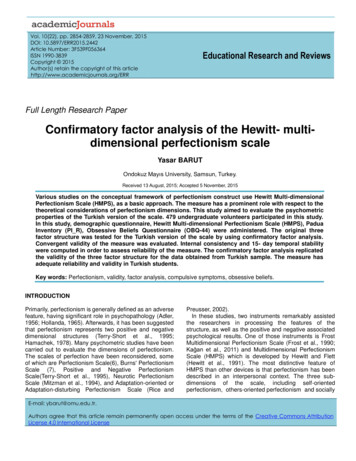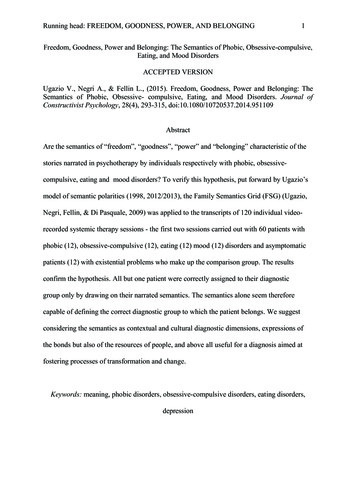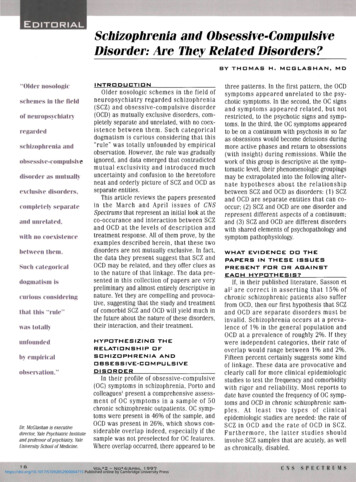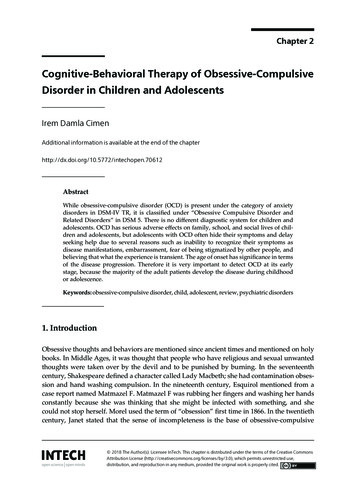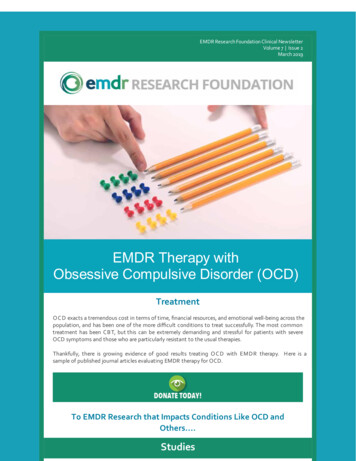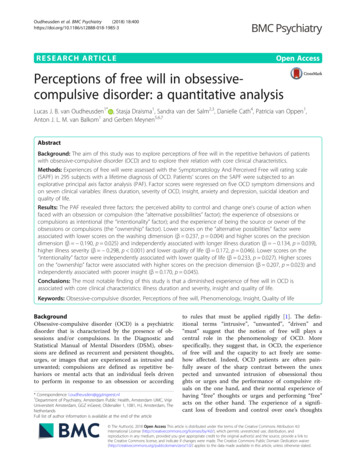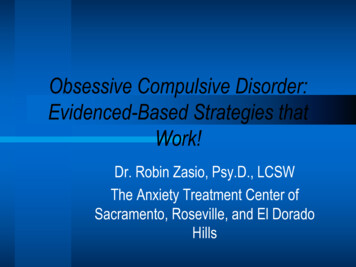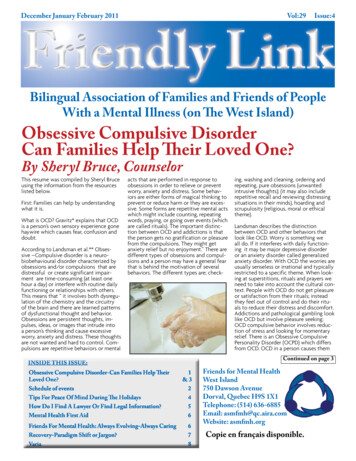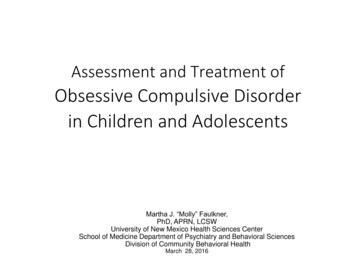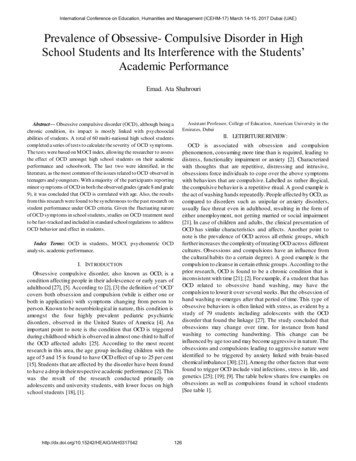
Transcription
International Conference on Education, Humanities and Management (ICEHM-17) March 14-15, 2017 Dubai (UAE)Prevalence of Obsessive- Compulsive Disorder in HighSchool Students and Its Interference with the Students’Academic PerformanceEmad. Ata ShahrouriAssistant Professor, College of Education, American University in theEmirates, DubaiAbstract— Obsessive compulsive disorder (OCD), although being achronic condition, its impact is mostly linked with psychosocialabilities of students. A total of 60 multi-national high school studentscompleted a series of tests to calculate the severity of OCD symptoms.The tests were based on M OCI index, allowing the researcher to assessthe effect of OCD amongst high school students on their academicperformance and schoolwork. The last two were identified, in theliterature, as the most common of the issues related to OCD observed inteenagers and youngsters. With a majority of the participants reportingminor symptoms of OCD in both the observed grades (grade 8 and grade9), it was concluded that OCD is correlated with age. Also, the resultsfrom this research were found to be synchronous to the past research onstudent performance under OCD criteria. Given the fluctuating natureof OCD symptoms in school students, studies on OCD treatment needto be fast-tracked and included in standard school regulations to addressOCD behavior and effect in students.II. LETERITURE REVIEW:OCD is associated with obsession and compulsionphenomenon, consuming more time than is required, leading todistress, functionality impairment or anxiety [2]. Characterizedwith thoughts that are repetitive, distressing and intrusive,obsessions force individuals to cope over the above symptomswith behaviors that are compulsive. Labelled as rather illogical,the compulsive behavior is a repetitive ritual. A good example isthe act of washing hands repeatedly. People affected by OCD, ascompared to disorders such as unipolar or anxiety disorders,usually face threat even in adulthood, resulting in the form ofeither unemployment, not getting married or social impairment[21]. In case of children and adults, the clinical presentation ofOCD has similar characteristics and affects. Another point tonote is the prevalence of OCD across all ethnic groups, whichfurther increases the complexity of treating OCD across differentcultures. Obsessions and compulsions have an influence fromthe cultural habits (to a certain degree). A good example is thecompulsion to cleanse in certain ethnic groups. According to theprior research, OCD is found to be a chronic condition that isinconsistent with time [21]; [2]. For example, if a student that hasOCD related to obsessive hand washing, may have thecompulsion to lower it over several weeks. But the obsession ofhand washing re-emerges after that period of time. This type ofobsessive behaviors is often linked with stress, as evident by astudy of 79 students including adolescents with the OCDdisorder that found the linkage [27]. The study concluded thatobsessions may change over time, for instance from handwashing to correcting handwriting. This change can beinfluenced by age too and may become aggressive in nature. Theobsessions and compulsions leading to aggressive nature wereidentified to be triggered by anxiety linked with brain-basedchemical imbalance [30]; [21]. Among the other factors that werefound to trigger OCD include viral infections, stress in life, andgenetics [25]; [19]; [9]. The table below shares few examples onobsessions as well as compulsions found in school students[See table 1].Index Terms: OCD in students, M OCI, psychometric OCDanalysis, academic performance.I. INT RODUCT IONObsessive compulsive disorder, also known as OCD, is acondition affecting people in their adolescence or early years ofadulthood [27], [5]. According to [2], [3] the definition of ‘OCD’covers both obsession and compulsion (while is either one orboth in application) with symptoms changing from person toperson. Known to be neurobiological in nature, this condition isamongst the four highly prevalent pediatric psychiatricdisorders, observed in the United States of America [4]. Animportant point to note is the condition that OCD is triggeredduring childhood which is observed in almost one-third to half ofthe OCD affected adults [25]. According to the most recentresearch in this area, the age group including children with theage of 5 and 15 is found to have OCD effect of up to 25 per cent[15]. Students that are affected by the disorder have been foundto have a drop in their respective academic performance [2]. Thiswas the result of the research conducted primarily onadolescents and university students, with lower focus on highschool students [18], [1].http://dx.doi.org/10.15242/HEAIG/IAH0317542126
International Conference on Education, Humanities and Management (ICEHM-17) March 14-15, 2017 Dubai (UAE)T ABLE 1: OBSESSION & COMP ULSIONO bsessionsAggre ssion – Fe arful ImpulseAn impulse to hurt self or othersAn impulse to steal or breakAn impulse to offend someoneRe pe titionAn impulse to repeat a doubt or questionExample: Repeated doubt if the door is locked.ContaminationImpulse or fear of being contaminated by everyday activities.Example: Shaking hand, opening door, etc.Distre ssAn impulse to keep things in order – alignedArousal of anxiety when finding things out of place or not in orderCompulsionsRe pe tition in Be haviorAn impulse to repeat an activity (triggered by an obsession)Example: Washing hands repeatedly due to obsession ofbecoming contaminatedRe pe tition in Me ntal ActExample: Counting or PrayingWhile OCD is termed as a rare disorder, it is found to beprevalent in about 2.5 per cent of the adults (as in USA), with alifetime prevalence in adolescents and children [16]. Also, it isidentified that females have dominance in OCD features overmales, as observed in various clinical trials [14]. The onset ofOCD is found to trigger during the adolescent age and increasegradually with age [10]. People reaching adulthood with OCDsymptoms are affected by impairment that may or may not relateto pursuing steady employment, marital difficulties or generalfunctioning [8]. In the case of adolescents and studentsidentified with OCD symptoms, it is found that theysubsequently become socially withdrawn and even conserveenergy and time to engage in this compulsive or obsessivebehavior [1].In terms of the treatments available for OCD, there are notreatment established to be successful; however, there aretreatments that are successful in controlling the OCD symptoms[30]. One such treatment is the CBT (Cognitive behaviortherapy) that is found to be effective [25]; [9]. It applies theprocess of exposing anxieties and fears in the OCD affectedindividuals, while instructing them on how to refrain from theircompulsions. They are supported with correct beliefs along withcritical evaluation of the fears on their future [9].In case of students, the behaviors of OCD can bemisunderstood, which raises the need for teachers to beequipped with the ability to recognize and understand OCDsymptoms and tendencies. Intervention can be applied only withincreased awareness, while significantly lowering the negativeeffect of the condition on the learning of students [12]. It isobserved that students identified with OCD condition mayperform worse in comparison with other students (below theactual potential), leading to less than average academicperformance [22]. This effect occurs as OCD symptoms 42and hinder the concentration ability as well as productivity ofstudents.OCD effected students display the tendency to have higherdisorders related to learning, which may extend to nonverballearning [19]. This means that such students may lack behind incomparison with other students, in terms of verbal skills such asspelling, reading and language. They may find it difficult to takeup tasks such as mathematics or writing by hand that needsvisual attention. Students with OCD can display character traitsthat limit their performance. Such traits include competitiveness,self-criticism, incessant tension/worry, dissatisfaction overperformance, controlling, procrastination and increasedexpectations [22]. These traits need to be carefully noted by theteachers when they start interfering with the functioning of thestudents with OCD and avoid misunderstanding them. It caneven lead to frustration, depression and/or discouragement ofthe students.Prior research on OCD and its effect on academic performanceof students has been employed for school grade students [13];[9]; [28]. Various implications were raised based on the abovefinding; however, the issue was not fully addressed . OCD incase of students made them believe that they read the studymaterial, while they have not [30], while other research [20]highlighted that OCD in students raises the barriers of academicperformance Examples include students reworking on theirresearch paper 10 to 15 times to perfect it, or preparing a detailed‘to-do’ list that extended their submission by years [16]. Adetailed analysis of the literature reflects the fact that OCD inschool students and its effect on their academic performance isnot examined in detail.III. METHODOLOGYSettingThe participants in this research were subjected toconvenience sampling from two grades (Grade 8 and Grade 9)classes in a school in Dubai, United Arab Emirates. The classesselected for the high school students were taught by the sameteacher in similar educational conditions. The name and locationof the school was kept anonymous due to confidentialitypurpose.The ParticipantsThe total size of each class involved in this research includesof 70 students. The prior academic performance of theparticipating classes was not shared with the researcher, in orderto avoid any form of bias during this research. Out of the 70students, five students were absent during the period in whichthe data for this research was being collected. volunteer bias isunlikely; this is because the participating students did not haveany past knowledge on this form of research. Two studentsshow their unwillingness to participate. A total of 63questionnaires were distributed amongst the class for datacollection, out of which 60 responses were completed with 3responses eliminated due to incompletion of the questionnaire.For the statistical testing, only the fully completed 60questionnaires were included in sample. Amongst the 60127
International Conference on Education, Humanities and Management (ICEHM-17) March 14-15, 2017 Dubai (UAE)The final grades of the participating students were assessedby the class teacher, and later used by the researcher to matchwith the student ID numbers collected. However, the ID numberswere later dismissed before conducting the statisticaltests with the academic grades.respondents, 36.6 per cent are males and 63.3 are females. Theaverage (mean) age of the sample population was identified as13.36 (SD 4.1, range 13 to 15). The demographic diversity ofthe sample population was not measured.IV. PROCEDUREV. QUEST IONS AND RESULT SThe academic performance assessment was performed duringthe mid-term and end-term. This consideration was made toensure that the participating students didn’t exit the researchand in turn, cause an effect on the findings. The students wereinitially briefed about the research and its importance, and weresubsequently invited to participate in the research of their freewill. The students were pre-informed that that the research willhave access to their academic performance, while emphasizingthat students can exit the research anytime during the process. Itwas also made clear to the students that their name, school ID,gender or nationality will not be revealed, and age and genderdetails will be considered as a whole for statistical evaluation.Also, the above details will not be shared with the classinstructor. During the process of data collection, theparticipating students were given the freedom to ask questionsabout the research and their inputs, and to clear any doubts theymay have about the process.The questions proposed in this study were as follow:1 st Question: Is there any significant differences between thetwo classes (grade 8 and grade 9) in OCD complaints in theirrespective scores of MOCI?In ordered to examine the differences between the two classes,an independent t-test performed on the data, the incorporationof these tests was needed to identify the difference in OCDcomplaints within the two classes. The 8th grade students (n 30,Mean 43.966) and 9th grade students (n 30, Mean 44.233).The calculated t-value (-3.125) is significant (.000) with DF 58.This result reflects significant differences in their respectivescores of MOCI in favour to grade 9. Table 2 illustrate the GroupComparison for OCD of grade 8 and 9.T ABLE II GROUP COMP ARISON FOR OCD OF GRADE 8 AND 9InstrumentsInitially, a demographic variable based survey was used tocollect information from the participating students. Thevariables consist of student age, gender, class and identificationnumber. The last variable was later eliminated. The duration ofeach class was 45 minutes with the maximum and minimumnumber of classes per day for the two grades was 8 and 9.2nd Question: Is there any correlation between academicperformance of students and the OCD complaint?To answer this question, correlation-based observationbetween the academic performance of students and the OCDcomplaint was conducted. A high score of MOCI in studentswith lower academic performance was registered (p 0.05). Itwas found that students with lower symptoms of OCD havedisplayed better academic performance. Moreover, the score ofMOCI was found to have no significance with the number ofstudy hours of the students.3rd Question: Is the score of MOCI can be applied to predictacademic performance of the students?The third test conducted using the sample data was linearregression. The aim was to identify if the score of MOCI can beapplied to predict academic performance of the students. Assupported by the correlational analysis above, a modest levelof MOCI scores was identified with significance with academicperformance p 0.05; R2 0.099).MOCI InventoryThe MOCI, also known as ‘Maudsley ObsessionalCompulsive Inventory’, was applied to the participants, this is awell-known instrument widely used to test OCD complaints, andhas been applied by various researchers in the past forinvestigating OCD symptoms among school and universitystudents [8]; [10]. In this research, the MOCI instruction wasutilized to assess the symptoms and effect of OCD in high schoolstudents.The instrument selected is specifically suitable for grouptesting, and hence, applied in this research study. It is a simpleinstrument that consumes a maximum of 15 – 20 minutes of theparticipants’ time to complete. The research instrumentcomprises of 30 questions that are presented in true/false format,the questions are developed in statements so that the studentscan easily understand and choose the correct response. A fewexamples of the questions include: (1) ‘I repeat some thingsagain and again’, (2) ‘I am very careful when I do my activities,but often feel that it is not right’. An overall index was providedby the MOCI, considering 30 as high and 1 as low, anddeveloping the scoring by the number of responses towards thehigh and low. In prior researches, the MOCI has been identifiedto have a good consistency, validity as well as stability [11].T ABLE 3 LINEAR REGRESSION MODEL FOR ACADEMIC P REDICTIONModel SummaryRR Square1.315a.099a. Predictors: (Constant), GRADEVI. DISCUSSIONIn this research, a detailed relationship analysis wasconducted between OCD and academic performance of studentat high school level as sample. In support to our hypothesis, apoor academic performance of school students was associatedwith OCD based behavior, with symptoms such as too muchAssessing Academic 7542Model128
International Conference on Education, Humanities and Management (ICEHM-17) March 14-15, 2017 Dubai (UAE)students thereby advancing in OCD understanding. Anotherlimitation of this research was the lack of ethnic inclusion in thedata collection, which thereby restrict detailing the findings withrespect to age and ethnic groups, and how each factor affectedacademic performance.Cultural factors have a certain level of influence on a student’sstudy habits and academic learning [24]. A study conducted by[14] examined obsessive and compulsive behavior in differentethnic groups in university students and found significantdifferences. Also, few authors [8] used a larger sample size withstudents from diverse ethnic groups that help achieveidentification of differences in OCD complaints across the ethnicgroups. The research should have used different methods ofacademic performance review apart from the grade point.However, this decision was to take straight forward approachand examine the grades to reach a clear analysis. Though theoutcome did reveal substantial significance between MOCIscores and academic performance of students, the grades wererestricted to one class. In future, inclusion of multiple classescan aid researchers in examining any diversity in the relationshipand if certain classes tend to increase OCD characteristics inschool students, tending to have visible effect on academicperformance.attention to detail, lack of confidence in executing a task,repeating activities and failing to complete activities. Highschool students that displayed lower symptoms of OCD werefound to have a better academic performance over students withOCD symptoms in both the grades. These results aresynchronous with the prior findings on OCD in school students[12]; [23]; [30].High school students with lower study hours were found tohave reported compulsive behavior and obsessive thoughts.This can be attributed to ‘perfectionism’, leading to symptoms ofOCD [4]. These are found to interfere with the academicperformance of university students [16], as well as withadolescents [1]. In our research, it can also be due to the reasonthat few students feel satisfaction in the amount of efforts theyhave put in their respective academic performance. Or, they mayhave felt overwhelmed due to the large amount of academicactivities in the school curriculum that made them overlook theiracademic performance. The results identified in this research canalso be attributed due to the students engaging in behavior ofOCD, thereby affecting their performance due to thesesymptoms.VII. COMPARAT IVE A NALYSISThe symptoms of Obsessive compulsive behavior were foundto be significantly higher in grade 9 students over grade 8. Thisfinding was slightly expected in line with the findings fromprevious research [12], that conclude OCD behavior mayincrease with age. While the age gap between the students fromthe two grades can be overlooked, however, the validity of thisfinding cannot be exempted. The average of grade 9 score ofMOCI is almost similar to that of grade 8 (see table 2). This can bedue to the fact that the two classes comprise of a mixednationalities and gender in almost similar proportions. Also, thecompetitive study environment may have triggered the feeling inthe students to be perfect and achieve higher scores leading todisplay of symptoms of OCD. Another point to note is thesignificance found between OCD symptoms and academicperformance of grade 9 to be higher in MOCI scores too, with therespective students earning lower academic performance.In the higher class, the OCD complaints were identified not besignificantly high in students with more age over the others.This can be attributed to the high school level of both grade 8and 9, learning under similar educational environment. Adifference may have been observed if the comparison was madebetween middle school students and high school students, withmore clear age differences and academic learning syllabus.IX. IMPLICAT IONSIn the school, educational system, educators and teachersshould pay attention towards any sign of obsession orcompulsive behavior amongst school students and report anyidentification to initiate corrective action [5]. They should bemade aware of the potential effect of OCD on school studentsand their adulthood, as OCD is a condition that can persist evenafter schooling.There are various variations in OCD based behavior in theacademic field at school level, which as reported by [9]; [5] mayextend to college level. It can emerge in terms of (1) inability ordifficulty to take note, (2) repeating an activity such as reading aline several times, (3) paying detailed attention and rearrangingthings again and again (example: academic supplies). OCDbehavior can be found is adolescents too, however, it is difficultto identify and control. With respect to school students, it canbe identified and hence controlled so that the student maybenefit. As indicated by [17], cognitive performance of studentsmay have an affect due to obsessive intrusions that distract thestudents thus affecting their overall academic performance.Also, it affects their ability to make decisions or prioritizingactivities/tasks leading to absenteeism and tardiness [12].To identify any pattern or features of obsession orcompulsion in students, a procedure comprising of MOCI,similar to that applied by other researchers for high schoolstudents and college students, can be applied [21]. The highschool students can be screened in order to identify thesymptoms through the self-reporting system. This can beachieved either by (1) taking up a confidential screening (one toone) with the students, (2) conducting question and answersessions thereby allowing students to ask and clear their doubtson what comes under OCD and how to control it, (3) using aMOCI test to access academic difficulty due to OCD.VIII. LIMIT AT IONSOne major factor that governed this research was the smallsample size. The negative effect of this is restricting thestatistical testing in order to examine relationship between thevariables. However, it cannot be accounted for as the standarddeviation was found to be adequate for review. Another point isthe low findings on OCD as only 18% of the participantsreported symptoms of OCD, through the MOCI scores.However, as this is not a clinical or sub-clinical examination, infuture, researcher may streamline this research on OCD in 29
International Conference on Education, Humanities and Management (ICEHM-17) March 14-15, 2017 Dubai (UAE)[5]For students with obsessive-compulsive behavior, it is veryimportant to have assessment as they may be exposed toembarrassment or criticism [23]. This affect can force them toconceal their behavior or doubts on how to control theirobsession-compulsions, while not seeking any assistance asrequired. It is vital to raise encouragement amongst such schoolstudents to avail assistance so that they do not lose out onacademic opportunities. Also, it is crucial as not doing so canlead to underestimation of OCD in school students.[6][7]X. INT ERVENT IONObsessive compulsive behavior in students can be presumedto be conscientious or something that relates to the personalqualities of the student affecting his/her academic performance.Though this is widely exaggerated, in reality, it is a problem thatseeks timely and effective intervention and support [30].Students identified with clear OCD issues are recommendedtreatment; however, this is delivered in the form ofpsycho-pharmacological and cognitive behavioral intervention(in combination) [23]. These interventions are delivered onschool campus allowing them the needed support to control andovercome their obsessions and compulsions. These otherwisemay have led to isolation or ridicule from fellow students [37].The most important step is to make the students aware of suchcondition and how it is affecting their personal and academic life.It should be made a standard service by including in the schoolservices, while the school body entering partnership withhealthcare bodies to provide the needed support.[8][9][10][11][12][13]XI. CONCLUSIONObsessive compulsive Disorder (OCD) is a psychiatriccondition that is debilitating in nature and can extend toadulthood in school children. The symptoms of this conditionmay initiate during the school age or as early as adolescence. Itcan subsequently extend its affect not only on the personalhealth of the student but also, the academic performance.Factors such as delay in identification or unwillingness ofparents to accept the symptoms may further delay appropriatediagnosis of this condition. Upon diagnosis, the studentchildren can be treated for the condition through therapy or withmedication in combination thereby bringing in positive effect.However, leaving OCD untreated puts the school students atrisk of further deepening the condition.[14][15][16][17]REFERENCES[1]Adams, G. B, Waas, G. A., March, J. S., and Smith, C. M., (1994).Obsessive-compulsive disorder in children and adolescents. Schoolpsychology Quarterly, 9, 274 – 294.https://doi.org/10.1037/h0088290[2] APA. (2000). Diagnostic & Statistical Manual of Mental Disorders.4 Ed. Washington, DC: Author.[3] American Psychological Association. (2000). Diagnostic andstatistical manual of mental disorders (4th ed., text rev.).Washington, DC: Author.[4] Adams, G. B., & Burke, R. B. (1999). Children and adolescents withObsessive-Compulsive Disorder. Childhood Education, 76(1), 19][20][21][22]130Adams, G. B. (2004). Identifying, assessing, and treatingObsessive-Compulsive Disorder in school-aged children: T he role ofschool personnel. Teaching Exceptional Children, 37(2), Brown, A, Di Nardo, A, Lehman, L, and Campbell, A, (2001).Reliability of DSM-IV anxiety and mood disorders: implications forthe classification of emotional disorders. Journal of AbnormalPsychology, 111, pp. Calvocoressi, M, et al. (1999). Family accommodation of obsessivecompulsive symptoms: instrument development and assessment offamily behavior. Journal of Nervous and Mental Disease, 187, 10000-00008Cameron, C. (2007). Obsessive-compulsive disorder in children andadolescents. Journal of Psychiatric and Mental Health Nursing ,14(7), 7.01162.xCameron, D. L., & Region, C. H. (2007). Obsessive-CompulsiveDisorder in children and adolescents. Journal of Psychiatric andMental Health Nursing, 14, .01162.xDurdle, H. (2008). A Meta-Analysis Examining the Relations amongPathological Gambling, Obsessive-Compulsive Disorder, andObsessive-Compulsive T raits. Psychological Reports, 103(6), cher, J., and Corcoran, K. (1994). Measures for clinical practice –a source book. (2 ed). New York: T he free press.Freeman, J. B., et al. (2007). Cognitive behavioral treatment foryoung children with Obsessive-Compulsive Disorder. BiologicalPsychiatry, 61, 12.015Frost, R. O., Sher, K. J., and Geen, T . (1986). Psychotherapy andpersonality characteristics of nonclinical compulsive checkers.Behaviour Research and Therapy, 24, 133 – nstede, M., Gidron, Y. and Nyklíček, I. (2008). T he Effects of aMindfulness Intervention on Obsessive-Compulsive Symptoms in aNon-Clinical Student Population. The Journal of Nervous andMental Disease, 196(10), 786b8Heyman, I., Fombonne, E., Simmons, H., Ford, T ., Meltzer, H., &Goodman, R (2001). Prevalence of Obsessive-Compulsive disorder inthe British nationwide survey of child mental health. The BritishJournal of Psychiatry, 179, hes, C and Campbell, L. (1991), Character Style and career andeducational concerns in college students, Journal of college studentpsychotherapy, 5, 23 – 45https://doi.org/10.1300/J035v05n04 03Maki, S., et al. (1994). Do clinical checkers exhibit deficits incognitive control? Behaviour Research & Therapy. 94)90111-2National Institute of Mental Health. (2008). P.A.N.D.A.S. RetrievedMay 08, 2016, from http://intramural.nimh.nih.gov/pdn/web.htmOldham, J. M., and Morris, L. B. (1995), New personalityself-portrait. New York: Bantam.Paige, L. Z. (2007). Obsessive-Compulsive disorder. PrincipalLeadership, 8(1), 12–15.Parker, Z., & Stewart, E. (1994). School consultation and themanagement of Obsessive-Compulsive personality in the classroom.Adolescence, 29, 563–574.Penn, J. V., & Leonard, H. L. (2001). Diagnosis and treatment inchildren and adolescents. In M. T . Pato & J. Zohar (Eds.), Current
International Conference on Education, Humanities and Management (ICEHM-17) March 14-15, 2017 Dubai (UAE)[23][24][25][26][27][28][29]treatments of Obsessive-Compulsive disorder (pp. 109–132).Washington, DC: American Psychiatric PublishingPiacentini, J., Bergman, R., Keller, M. and McCracken, J. (2003).Functional Impairment in Children and Adolescents withObsessive-Compulsive Disorder. Journal of Child and AdolescentPsychopharmacology, 13(supplement 1), 9Piacentini, J., & Bergman, R. L. (2000). Obsessive-Compulsivedisorder in children. The Psychiatric Clinics of North America, )70178-7Rasmussen, S. A., & Eisen, J. L. (1990). Epidemiology ofobsessive-compulsive disorder. Journal of Clinical Psychiatry,53(Suppl.), 10–13, Discussion 14.Rettew, D. C., Swedo,
Obsessive compulsive disorder, also known as OCD, is a condition affecting people in their adolescence or early years of adulthood [27], [5]. According to [2], [3] the definition of ‘OCD’ covers both obsession and compulsion (while is either one or both in a
